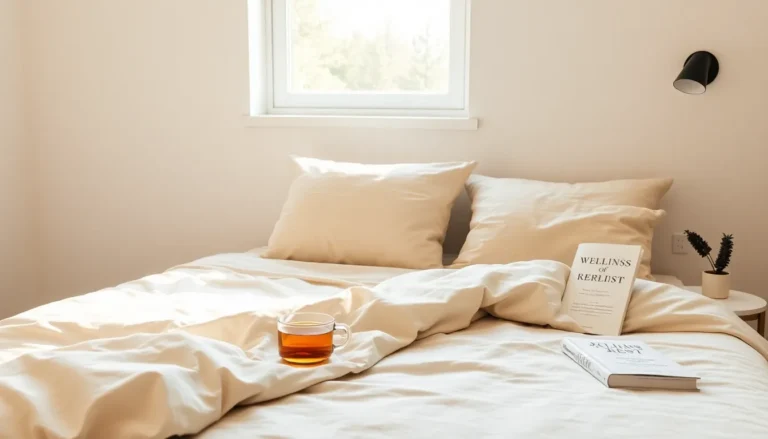Table of Contents
ToggleChoosing the right color tone for an outfit can feel like trying to solve a Rubik’s Cube blindfolded. With so many shades and hues, it’s easy to get lost in a sea of fabric. But fear not! Color tone outfit layouts are here to save the day, transforming your wardrobe from drab to fab faster than you can say “fashion emergency.”
Understanding Color Tone Outfit Layouts
Color tone outfit layouts simplify the process of choosing outfits by categorizing clothing options based on their tonal qualities. These layouts help individuals make informed decisions that enhance their overall style.
What Are Color Tones?
Color tones represent the variations in shades within a hue. Different tones, such as warm, cool, and neutral, contribute significantly to outfit aesthetics. For example, warm tones include reds and oranges, while cool tones encompass blues and greens. Recognizing these distinctions allows individuals to curate outfits that complement their unique style. Specific tones can evoke various emotions or themes, enabling the wearer to express their personality through fashion choices.
Importance of Color in Fashion
Color plays a crucial role in fashion as it affects perception and mood. It influences how others perceive the wearer and can evoke feelings of confidence or calmness. Studies show that appropriate color choices can enhance visual appeal and attract attention. Coordinating colors effectively can create a cohesive look and elevate one’s wardrobe. Understanding color theory is essential for individuals seeking to enhance their style by ensuring harmony and balance in their outfits.
Types of Color Tone Outfit Layouts
Exploring various color tone outfit layouts helps individuals create stylish ensembles. Each layout offers distinct ways to combine hues and shades effectively.
Monochromatic Outfits
Monochromatic outfits use variations of a single color. For instance, different shades of blue, like navy and sky blue, create a cohesive look. This approach emphasizes simplicity and elegance. Monochromatic styles often utilize textures to add depth, preventing the outfit from appearing flat. It’s easy to accessorize with neutral or similar shades to maintain harmony. Creating a breathtaking monochromatic look can make a bold fashion statement that reflects personal taste.
Complementary Color Combinations
Complementary color combinations involve pairing colors opposite each other on the color wheel. Examples include blue and orange or red and green. This method generates striking contrasts that capture attention. Using complementary tones brings vibrancy to outfits without overwhelming the viewer. Balancing bright hues with neutral pieces stabilizes the overall appearance. Experimenting with complementary colors can elevate everyday outfits to stylish levels.
Analogous Color Schemes
Analogous color schemes consist of colors located next to each other on the color wheel. An example is red, red-orange, and orange. This layout creates a harmonious effect, offering a soft and pleasing aesthetic. Outfits using analogous tones enable smooth transitions between shades, promoting a fluid visual experience. Incorporating textures and patterns enhances the overall complexity of the ensemble. Individuals often find it easier to achieve a balanced look with analogous color schemes.
Tips for Creating Effective Color Tone Outfit Layouts
Creating effective color tone outfit layouts involves a few strategic approaches. Following these tips helps enhance wardrobe choices and personal style.
Assessing Skin Tone and Undertones
Understanding skin tone and undertones is crucial for selecting flattering colors. Warm undertones typically pair well with earthy colors like oranges and yellows. Cool undertones look great with shades such as blues and pinks. Individuals with neutral undertones can experiment with both warm and cool palettes. Checking the veins on the wrist can assist in determining undertones, with blue veins indicating cool undertones and green veins suggesting warmth. By assessing these factors, individuals can curate outfits that enhance their natural beauty.
Choosing the Right Color Palette
A well-chosen color palette makes outfits cohesive and visually appealing. Selecting a combination of three to five colors provides versatility and balance. Popular choices include monochromatic schemes that focus on variations of a single hue. Complementary palettes, which feature opposing colors on the color wheel, create striking contrasts. Analogous combinations, using colors next to each other, result in a harmonious appearance. Experimenting with different palettes allows individuals to find combinations that suit their style and mood. This process can enhance overall outfit aesthetics significantly.
Balancing Patterns and Textures
When combining patterns and textures, balance remains essential for achieving a stylish ensemble. Mixing patterns, such as stripes with florals, creates visual interest but requires careful consideration of scale. Smaller patterns can complement larger ones effectively. Incorporating different textures adds depth, making outfits more dynamic. Materials like denim, lace, or leather can elevate the overall look. Ensuring that patterns and textures coordinate with the chosen color palette creates a cohesive style. Ultimately, this balancing act leads to a more polished appearance.
Examples of Color Tone Outfit Layouts
Color tone outfit layouts provide various styling options suited for different occasions and seasons. Here are detailed examples for casual, formal, and seasonal looks.
Casual Looks
Casual outfits often emphasize comfort and individuality. Warm tones like mustard or olive can create a relaxed vibe for everyday wear. A combination of a beige sweater with rust-colored joggers can convey ease while staying stylish. Accessories in soft earth tones like terracotta or cream can enhance the look. Pairing a denim jacket with a fitted white t-shirt and olive green chinos also works well. Mixing textures, such as denim and knitwear, adds depth while keeping the ensemble laid-back.
Formal Attire
Formal outfits require a sophisticated approach, often focusing on sleek color tones. Cool tones, including navy, charcoal, and deep green, set a refined mood for business or formal events. A charcoal suit with a crisp white shirt provides a timeless appearance, while a navy dress shirt under a lighter gray blazer offers a contemporary twist. Accessories like a burgundy tie or an emerald pocket square can elevate the outfit further. During formal gatherings, cohesiveness in color tones ensures an elegant and polished presentation.
Seasonal Outfit Ideas
Seasonal outfits highlight the beauty of color tones throughout the year. In spring, pastel colors like soft pink and mint green create a fresh and vibrant look. A floral dress in these hues can exude warmth and approachability. For summer, brighter tones such as aqua or vibrant yellow can energize casual ensembles. Combos like a white tank top and coral shorts are perfect for beach outings. Autumn favors warm tones, including burnt orange and deep amber. Layers like a mustard sweater over a rust-colored blouse make an inviting outfit for cooler weather. Winter often showcases darker shades; rich burgundy and deep navy are ideal for creating a cozy yet chic aesthetic.
Mastering color tone outfit layouts can transform anyone’s wardrobe into a personal style statement. By understanding the nuances of color tones and their impact on overall aesthetics, individuals can make confident fashion choices that resonate with their personality.
Whether opting for monochromatic schemes or exploring complementary and analogous combinations, the possibilities are endless. With a thoughtful approach to color selection and a keen eye for balance, anyone can elevate their outfits for any occasion.
Embracing these principles not only enhances visual appeal but also fosters a deeper connection to one’s unique style journey.




